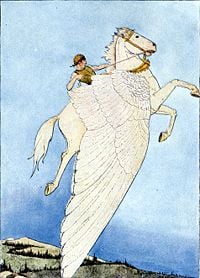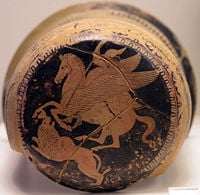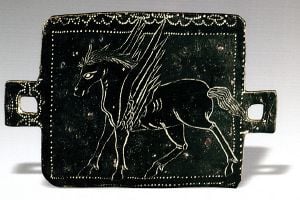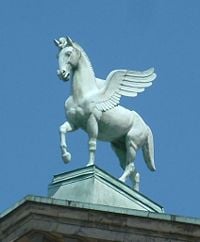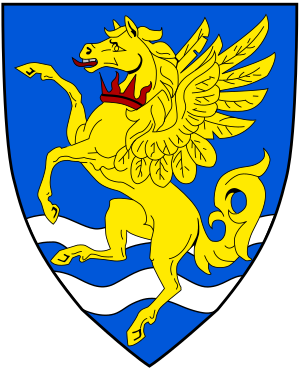Pegasus
There have many images of horses with wings throughout the ages, but all come from the creature in Greek mythology known as Pegasus, or Πήγασος (Pégasos)) in Greek. Variations of stories involving winged horses do exist, but the legend of Pegasus and the tragic hero Bellerophon is the most prominent. In modern culture, Pegasus has come to refer to all winged horses, not only the one of Greek mythology who was transformed into the constellation of his name upon his death. Pegasus is generally not considered to have a physical existence.
The symbolism of Pegasus, the hoofed master of the ground and winged master of the air, continues to represent speed, strength, and artistic inspiration. Encompassing beauty and a sense of majesty, it is a guide for humankind beyond the physical world to the realm where the spirit can soar without limit.
Etymology
Greek poet, Hesiod connects the name Pegasos with the word for "spring” or "well," pēgē. Everywhere the winged horse struck hoof to earth, an inspiring spring burst forth: one on the Muses' Mount Helicon, at the behest of Poseidon, to prevent the mountain swelling too much and another at Troezen. The actual etymology of the name is most likely from Luwian pihassas "lightning", or pihassasas, a weather god (the god of lightning). In Hesiod, Pegasos is still associated with this original significance by carrying the thunderbolts for Zeus.
Origin
Unlike some other mythical creatures, it is unlikely that Pegasus is based on a real animal of the time, or a misunderstanding of fossilized remains. Rather, Pegasus seems to be an entirely fictitious creation, although horses were often central in mythology and cultures (including the unicorn). It is generally accepted that when Perseus beheaded the Gorgon (more popularly known today as Medusa) Pegasus sprang forth from her severed neck, keeping in accord with the idea of a "higher" birth, like the birth of Athena from the head of Zeus. The most common variant states that Pegasus was born of the earth as Medusa's blood spilled onto it and then into the sea foam. Since the God of the Sea, Poseidon is often said to be the father of Pegasus, this account seems more congruent than the other, although the nature of Greek mythology is often fragmented and often lacks a clear sense of continuity.
Mythological references
Pegasus appears in the story of Bellerophon, the son of King Glaucus, a warrior known for his breeding of fierce horses who betrayed and devoured him. Bellerophon was rumored to come from divine parentage, but even if not, he was by far the strongest and most handsome young man in his kingdom. He desired to tame Pegasus and was shown a way by Athena after he slept in her temple one night; presenting him with a golden bridle, Bellerophon mastered Pegasus, and together the two had many adventures. It was because of Pegasus that Bellerophon was able to slay the Chimera, a fearsome conglomerate of a lion, goat, and serpent.[1]
Swift on the ground, and even more agile in the air, Pegasus' ability to master both land and sky lead Bellerophon to develop an exaggerated sense of pride, the main cause of a tragic hero's downfall in ancient Greece. Bellerophon tried to fly to Mount Olympus, the realm of the Gods, on Pegasus' back. Pegasus threw Bellerophon from his back for such blasphemous behavior, and was awarded his own place in Mount Olympus, in the stables where the horses that pulled Zeus's chariot were kept. Pegasus became the most prominent of all the horses, given the task of collecting thunderbolts and bringing them to Zeus when the God demanded them. [2]
Pegasus, not being immortal, was eventually turned into a constellation, but a single feather fell to the earth near the city of Tarsus, which is how the city earned its name.
Pegasus today
In modern times, Pegasus became applied to flying horses in general, wherever they appear in art or literature. Viewed as a symbol of the soul able to fly beyond the realm of physical life, Pegasus is an inspirational magical creature endowing a sense of beauty and majesty to the works in which he appears. Pegasus has also been regarded as "the power of the creative spirit in all of us. He is the symbol of the Muses, of inspiration, and of the beauty we bring to our life and the lives of others."[3]
Heraldry
Of the mythical creatures represented in family crests and shields, Pegasus is not as predominant. However, there were some families known to bear the image of Pegasus, such as the Birchenshaw and the Cavalier families as well as Michael Drayton, the poet (1563-1631). Pegasus also appears in heraldic fashion on a shield in Westminster Abbey. Most of Pegasus images in heraldry features the animal cantering or with its front legs raised in the air and infrequently in mid-flight.[4]
Constellation
Like many other figures in Greek mythology, Pegasus was used to name a series of stars and space objects that make up a constellation. The figure that these objects create when imposed with lines is that of an upside-down winged horse, observable in the Northern hemisphere during the summer and fall, while in the Southern hemisphere it can be seen in the winter and spring. The stars in the constellation are not particularly bright or well known stars, but the constellation does contain M15, a globular cluster of galaxies. Because of the vastness of space, the constellation actually contains a portion of space that holds over a dozen galaxies. [5]
Notes
- ↑ Edith Hamilton, Mythology (Back Bay Books, 1998). ISBN 0316341517
- ↑ Micha F. Lindemans, "Pegasus" Encyclopedia Mythica. Retrieved March 8, 2007
- ↑ Ellie Crystal, "Pegasus" Ellie Crystal's Metaphysical and Science Website Retrieved March 21, 2007.
- ↑ "The Curiosity Corner: The Pegasus" Retrieved March 12, 2007
- ↑ "Pegasus" Windows to the Universe. University Corporation for Atmospheric Research (UCAR). ©1995-1999. Retrieved March 8, 2007
ReferencesISBN links support NWE through referral fees
- Conway, D.J. Magickal Mystical Creatures: Invite Their Powers Into Your Life. Llewellyn Publications, 2001. ISBN 156718149X
- Hamilton, Edith. Mythology. Back Bay Books, 1998. ISBN 0316341517
- Nigg, Joseph. The Book of Fabulous Beasts: A Treasury of Writings from Ancient Times to the Present. Oxford University Press, 1999. ISBN 978-0195095616
- Vinycomb, John. Fictitious and Symbolic Creatures in Art with Special Reference to Their Use in British Heraldry. Kessinger Publishing, 2004. ISBN 0766182487
External links
All links retrieved November 23, 2022.
- "Pegasos" from Theoi Project, Guide to Greek Mythology.
- "Pegasus: The Flying Horse" Constellations of Words.
Credits
New World Encyclopedia writers and editors rewrote and completed the Wikipedia article in accordance with New World Encyclopedia standards. This article abides by terms of the Creative Commons CC-by-sa 3.0 License (CC-by-sa), which may be used and disseminated with proper attribution. Credit is due under the terms of this license that can reference both the New World Encyclopedia contributors and the selfless volunteer contributors of the Wikimedia Foundation. To cite this article click here for a list of acceptable citing formats.The history of earlier contributions by wikipedians is accessible to researchers here:
The history of this article since it was imported to New World Encyclopedia:
Note: Some restrictions may apply to use of individual images which are separately licensed.
